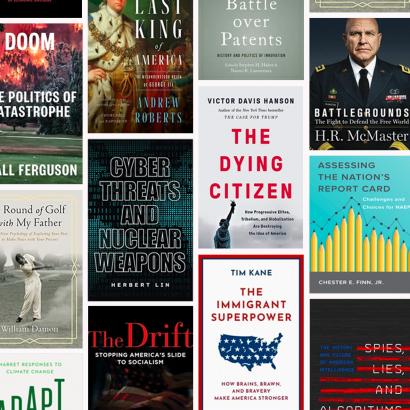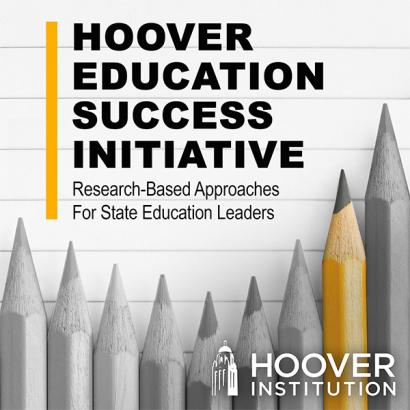- Science & Technology
- Understanding the Effects of Technology on Economics and Governance
Norbert Holtkamp is a Science Fellow at the Hoover Institution and a professor of particle physics and astrophysics and of photon science at SLAC National Accelerator Laboratory at Stanford University. He is a member of the Hoover Institution’s Technology Policy Accelerator, whose research and insights help government and business leaders understand emerging technology and its geopolitical implications. Martin Giles is the executive director of the Technology Policy Accelerator.
Martin Giles: Norbert, you are part of a working group looking at the benefits and risks of international research collaborations in science. What’s the background to this effort?
Norbert Holtkamp: The group I was part of worked with the National Science, Technology, and Security Roundtable of the National Academy of Sciences, Engineering, and Medicine, which has spent the past four years looking at the opportunities and risks associated with international research efforts—and why the US should stay engaged in such efforts. We hosted a meeting at Hoover in 2024 that brought together universities, National Labs, and other interested organizations. Since then, we’ve been studying the benefits of international scientific collaboration—not just with allies but also, in some cases, with geopolitical adversaries—as well as the risks involved. As part of this work, we have published a report highlighting some of the benefits the US and the world have gained from cross-border scientific exchanges.
Martin Giles: In what ways does international collaboration amongst scientists foster transparency and stronger relationships that benefit global security?
Norbert Holtkamp: There are cases where humanity as a whole wins. The work that’s been done internationally on the science of measuring earthquake activity doesn’t just help us better track naturally occurring seismic phenomena; it also enables detection of nuclear tests and therefore contributes to global security. Nuclear science is another good example. Sharing fundamental, unclassified data on nuclear reactions can accelerate the US’s development of next-generation reactors, which enhances our energy security. At the same time, the data can be used to help train international inspectors of nations’ nuclear programs.
There are also economic benefits. Advances in battery technology since the 1960s have taken us to the point where we now have tiny, lightweight batteries that can power smartphones and large ones that are used in electric vehicles. These are the products of research that’s been shared over time by scientists from many countries, including the US, Japan, South Korea, Europe, and China.
Martin Giles: As a scientist, you’ve been involved in some very large technology projects. Can you share how these have benefited from international perspectives?
Norbert Holtkamp: Sure. Early in my career, I was involved in the construction of the Spallation Neutron Source, or SNS, at Oak Ridge National Laboratory. The facility operates an accelerator-based system producing particles called neutrons used to examine the structures of all kinds of materials. The SNS can analyze small objects and even very large ones, such as jet engines. Although it was paid for and built in the US, the facility relied on a significant amount of technology developed overseas and on expertise contributed by foreign as well as US scientists.
Another example is at the SLAC National Accelerator Laboratory, where I used to be deputy director before coming to the Hoover Institution in 2023. Located here at Stanford University, SLAC is home to the world’s most powerful laser, the Linac Coherent Light Source X-ray free electron laser, which researchers in many fields—including quantum science, fusion technology, and materials development—use to study atomic-scale phenomena. The laser was conceptualized here and funded by the Department of Energy, but its development also relied significantly on expertise from overseas.
Martin Giles: What are some of the indirect benefits America gets from engaging in international scientific research efforts?
Norbert Holtkamp: Well, by engaging with researchers from other countries, we expose them to US culture, and they get to see what a great place this is to live and work. Early-career researchers who come to the US as graduate students or postdoctoral fellows subsequently become permanent residents and many remain here and become US citizens, employed at National Labs, universities, and research centers as well as by the private sector. America benefits from this “brain gain” in the form of research advances it would not otherwise have had. Many of these researchers also transfer their expertise to innovative companies, which adapt them for commercial use, or they become founders themselves.
It’s important to remember, too, that you don’t get innovation just from reading other researchers’ papers and listening to conference talks. Major advances often come from sharing knowhow gained from hands-on experiences in labs and other facilities, which happens via a multitude of informal contacts. This tacit knowledge is vital to innovation.
Martin Giles: You make a convincing case for the benefits of international scientific collaboration. But what about the risks? How should we be thinking about—and managing—these?
Norbert Holtkamp: For sure, there are risks—and we need to think about how to address these very carefully. In the postwar era and up until about twenty years ago, there was a widespread understanding that collaboration on basic science was a common good. Then some countries began to move away from this unwritten consensus, seeking to exploit US innovations for their own advantage and closing off access to their own research. The result has been a swing towards more stringent rules governing when and how US scientists can share data and facilities with foreign researchers both here and abroad.
Martin Giles: So how do we strike the right balance here to ensure our international research partnerships remain beneficial and secure?
Norbert Holtkamp: It requires a multilayered approach. This begins before we interact with foreign scientists. Universities and other institutions don’t have the appropriate intelligence and other resources to be able to work out whether a researcher should be allowed into the US or not. That vetting needs to be done by the government. The same holds true of vetting of the foreign institutions that they work for and that the US researchers want to work with. We can provide universities with tools for analyzing potential risks that can help here—and that is a focus of the SECURE project co-led by some of my colleagues at Hoover and funded by the National Science Foundation.
Next, we as scientists need more rigorous training in how to assess the risks that arise from engaging in collaborations. As I just said, we can’t be the front line of defense, but we should play an important role in it. After the end of the Cold War, this kind of training declined, and we need to reinvigorate it. The scientific community also needs to regularly evaluate when basic science projects that may or may not yield valuable applications have reached a point where the applications could have sensitive national or economic security implications. This analysis isn’t a one-and-done thing; we need to regularly re-evaluate projects as they develop. Obviously, highly sensitive areas such as research into hypersonic technologies used for missiles should be very tightly scrutinized.
Universities and other research institutions have all implemented administrative checks and balances, but these can become cumbersome. International collaborations can accelerate basic research significantly—and we show some examples of this in our report—so it’s crucial that risk taking and risk management are appropriately balanced or we might lose the race to lead in advanced technologies.
Martin Giles: You’ve written about what you call a “PreCheck lane” approach to managing risks in international collaborations. Can you explain what this is?
Norbert Holtkamp: The need for greater protection of our research advances and intellectual property is clear. However, the regime that’s been put in place could better distinguish between allies and rivals. What my co-authors, Thom Mason and Anna Puglisi, and I suggested is that the US should adopt an approach that makes it easier for American researchers to collaborate with those that are aligned with US values and whom we consider to be allies. In the same way that there are special lanes at airports for prescreened travelers, what we need is a “PreCheck lane” for collaborations with allies, where prescreened countries and entities don’t face the same level of scrutiny and checks as others.
The United States has to keep moving very fast in areas such as AI, semiconductors, biotechnology, and material science if it’s going to win in the new era of technological competition that’s also reshaping geopolitics. You can be sure our geopolitical rivals aren’t going to take their foot off the research accelerator in these and other key areas. Making international collaboration harder with allies slows us down—and that could pose an even bigger risk to our national security in the future.

















